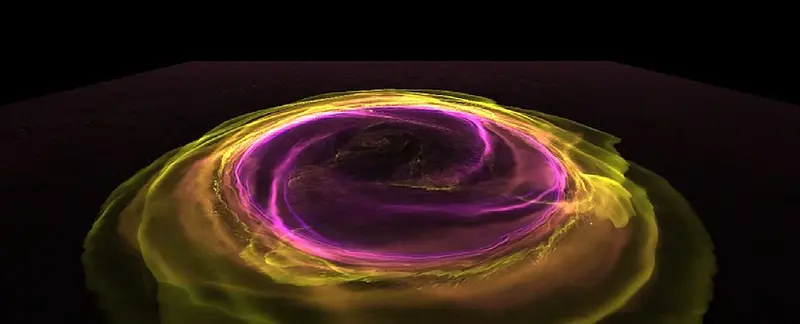Scientists staged thermonuclear explosion on computer
- March 25, 2024
- 0
When a neutron star absorbs matter from a nearby binary star, the unstable fusion burning of this accumulated matter can cause a wild explosion that sends X-rays into
When a neutron star absorbs matter from a nearby binary star, the unstable fusion burning of this accumulated matter can cause a wild explosion that sends X-rays into

When a neutron star absorbs matter from a nearby binary star, the unstable fusion burning of this accumulated matter can cause a wild explosion that sends X-rays into the universe. Exactly how these powerful bursts develop and propagate across the surface of a neutron star remains a mystery. But scientists trying to recreate observed X-ray bursts through simulations are learning more about their advantages and disadvantages, as well as the extremely dense neutron stars that produce them.
“With simulations, we can see in finer detail how these events happen,” says computational astrophysicist Michael Zingale of the State University of New York at Stony Brook.
“One of the things we want to do is understand the properties of a neutron star, because we want to understand how matter behaves at the extreme densities found in a neutron star.”
Neutron stars are among the densest objects in the universe. This is what’s left after a massive star has run out of fuel and exploded as a supernova. However, as the outer material escapes into space, the star’s core collapses under the force of gravity, forming a superdense sphere approximately 20 kilometers (12 miles) in diameter, squeezing the mass of approximately 2.3 Suns into this small sphere.
One would expect the material compressed so tightly to be a bit strange, to say the least. But by studying thermonuclear explosions, scientists can impose constraints on their size, which can help model their interiors.
For various reasons (distance, danger, etc.) we cannot get close enough to a neutron star to take a closer look, but we can collect all the information we need about the neutron star’s X-ray emission. explosions and try to make a simulation whose results match the observation data.
It sounds simple, but the physics of neutron stars is really complex; Modeling their behavior requires a lot of computing power. In previous work, researchers used the Summit supercomputer at Oak Ridge National Laboratory to simulate a two-dimensional fusion flame. They have now continued this work and extended their simulations to the third dimension.
“The big goal is always to relate simulations of these events to what we observe,” Zingale explains. “Our goal is to understand what the underlying star looks like, and it’s vital to explore what these models can do at different sizes.”
The three-dimensional neutron star model had a temperature several million times hotter than the Sun and a rotation rate of 1,000 cycles per second; This was quite close to the theoretical upper limit of the neutron star’s spin rate. They then modeled the early evolution of the thermonuclear flame.
Although the flame spread slightly faster in the 2D simulation than in the 3D version, the growth trends in both models were very similar. This agreement means that 2D modeling remains a good tool for studying these turbulent explosions, but there are still some things it cannot do. For example, turbulence behaves differently in two and three dimensions; But being able to use a 2D simulator for the parts it can do will free up computing power for other things, like improving registration accuracy.
With this information in hand, simulations can be run to get a realistic understanding of how neutron stars go about their giant tantrums.
“We came close to modeling the propagation of the flame from pole to pole across the entire star,” says Zingale. “This is exciting.” The study was published on: Astrophysical Journal.
Source: Port Altele
As an experienced journalist and author, Mary has been reporting on the latest news and trends for over 5 years. With a passion for uncovering the stories behind the headlines, Mary has earned a reputation as a trusted voice in the world of journalism. Her writing style is insightful, engaging and thought-provoking, as she takes a deep dive into the most pressing issues of our time.